Samsung Galaxy S 5 Review
by Anand Lal Shimpi & Joshua Ho on April 8, 2014 12:00 AM EST- Posted in
- Smartphones
- Samsung
- Mobile
- Galaxy S 5
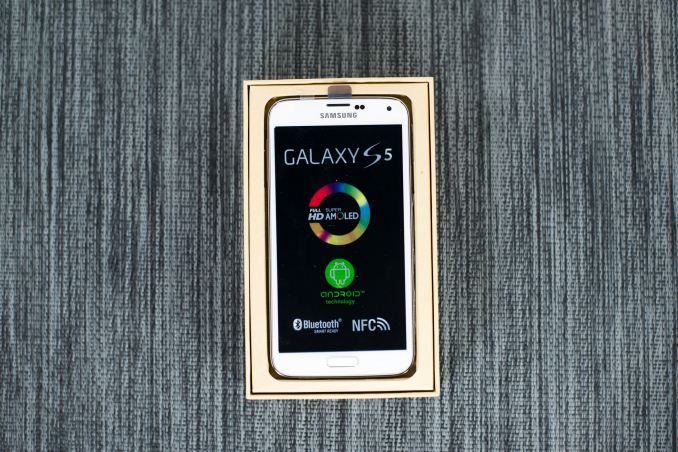
Samsung is now the undisputed king of the Android smartphone space. It was only a few years ago that the general public referred to every Android phone as a “Droid”. Now, it’s not uncommon for people to refer to every Android device as a “Galaxy”, and it speaks to the level of market penetration that Samsung has achieved with their Galaxy line-up. The Galaxy S series has been a sales hit, and with the initial impressions piece, it was said that the average consumer lives and dies by what’s familiar. Samsung continues to iterate with their Galaxy S line with consistent improvement and little, if no regression from generation to generation. This is where Samsung dominates, as the Galaxy S5 is clear evolution of the Galaxy S3 and S4, but made more mature.
The inspiration of the Galaxy Note 3 is also evident in the Galaxy S5’s design. Like the Note 3, the sides of the phone have the same ribbed chrome-colored plastic, which helps with gripping the phone. The front, like the Note 3, also has a subtle pattern beneath the glass. The same layout that has been used since the original Galaxy S is still mostly unchanged here.
There’s a single rectangular home button, with two capacitive buttons on the side and an earpiece on top, with holes for the sensors. There’s also a noticeable lip as you swipe off the glass lens, which is noticeably thicker than the one on the Galaxy S4. This lip keeps the glass from touching the surface if the phone is set face down on a table. The only major departure on the front is the capacitive button configuration which replaces the menu action overflow button with a multitasking button, something that has been sorely lacking from Galaxy phones, although this change is likely to annoy those that preferred to have a dedicated menu button. On the bright side, long pressing the multitasking button acts as an action overflow button.
On the back, the phone has undergone some serious changes, although it’s still quite familiar. The speaker is still present, as is the camera bump with the flash module underneath. The heart rate sensor is also next to the flash, and the single speaker is on the back as well. What’s really interesting is that the texture is no longer glossy. The back has a grid pattern of indentations in it that help with gripping the phone, and there’s a noticeable texture that seems to resemble the same pattern that the Note 3 had, but there’s no stitching to suggest a faux-leather texture. Along the sides, the power button is on the right side, the volume rocker on the left. The IR transmitter continues to be in the same position that it was before, as is the 3.5mm headphone jack which is on the top right. The microUSB 3.0 port is on the bottom, covered by a flap that is supposed to protect against water immersion according to IP67 spec.
Overall, while the Galaxy S5 isn’t as nice in the hand as the HTC One (M8), it’s certainly not as bad as the Galaxy S4 or S3. I have to say that compared to the GS4, the back makes a huge difference in improving the feel of the device. It's not what I'd consider premium (despite the GS5's price point), but it's much better than before.
While the Galaxy S4 and HTC One were generally comfortable to use, the Galaxy S5 and HTC One (M8) are both teetering at the edge of too large. I found that both are effectively sitting right at the edge of what I’d consider to be usable with one hand. HTC continues to have a bit more ergonomic shape as the rounded back cover fits in the hand better, although it makes the phone have a higher maximum thickness.
Taking off the back cover of the phone, it’s clear that the entire phone has been designed with water resistance in mind, as there’s a rubber gasket all along the back cover, and there’s an extra plastic snap in the center that helps to ensure that the gasket seals the phone properly. The GS5, like the GS4 Active, retains an IP67 (Ingress Protection) rating. The first digit (6) indicates that the design is fully sealed against dust, while the second digit indicates that the device is submergible up to 1 meter for up to 30 minutes. Another consequence of this need to waterproof the phone is that taking apart the phone for repair is no longer done by removing screws from the cover that is underneath the backplate unlike the Galaxy S4. Instead, based upon some teardowns done by others, repairing this phone must be done by removing the display first, then the midframe and the rest of the phone can be accessed for repair. In short, the assembly of this phone most closely resembles the Galaxy S4 Active, which is hardly surprising because both are IP67 certified. However, as Samsung emphasized at their launch event, this doesn’t make the Galaxy S5 waterproof in any way.
Outside of the physical construction of the device, the Galaxy S5 continues to ship the latest and greatest hardware for its time. Samsung has used the MSM8974ACv3 Snapdragon 801 for this phone, an updated AMOLED display with a claimed 500 nit brightness for outdoor visibility, and a new ISOCELL 16MP camera sensor. A comparison of the Galaxy S4 and S5 can be seen in the table below.
| Samsung Galaxy S4 | Samsung Galaxy S5 | |
| SoC | APQ8064AC 1.9 GHz Snapdragon 600 | MSM8974ACv3 2.45 GHz Snapdragon 801 |
| RAM/NAND | 2 GB LPDDR3, 16/32GB NAND + microSD | 2GB LPDDR3, 16/32GB NAND + microSD |
| Display | 5” 1080p SAMOLED HD | 5.1” 1080p SAMOLED HD |
| Network | 2G / 3G / 4G LTE (Qualcomm MDM9x15 UE Category 3 LTE) | 2G / 3G / 4G LTE (Qualcomm MDM9x25 UE Category 4 LTE) |
| Dimensions | 136.6 x 69.8 x 7.9 mm, 130 grams | 142 x 72.5 x 8.1 mm, 145 grams |
| Camera |
13MP (4128 x 3096) Rear Facing with 1.12 µm pixels, 1/3.06" CMOS size, 31 mm (35mm effective), 2MP F/2.4 FFC |
16MP (5132 x 2988) Rear Facing with 1.12 µm pixels, 1/2.6" CMOS size, 31 mm (35mm effective), 2MP FFC |
| Battery | 2600 mAh (9.88 Whr) | 2800 mAh (10.78 Whr) |
| OS | Android 4.4 with Nature UX 2.0 | Android 4.4 with TouchWiz |
| Connectivity | 802.11a/b/g/n/ac 1x1 + BT 4.0, USB2.0, GPS/GNSS, MHL, DLNA, NFC | 802.11a/b/g/n/ac 2x2 + BT 4.0, USB3.0, GPS/GNSS, MHL, DLNA, NFC |
| SIM Size | MicroSIM | MicroSIM |
Outside of camera, display, and SoC, battery gets a noticeable bump and a new higher voltage chemistry (3.8V vs 3.85V) , the WiFi solution becomes a dual spatial stream solution, and there's a mild increase to size and mass.


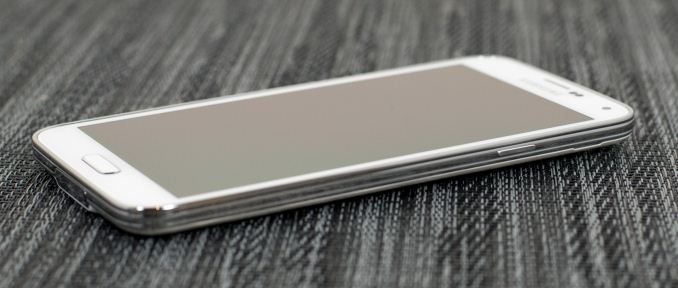
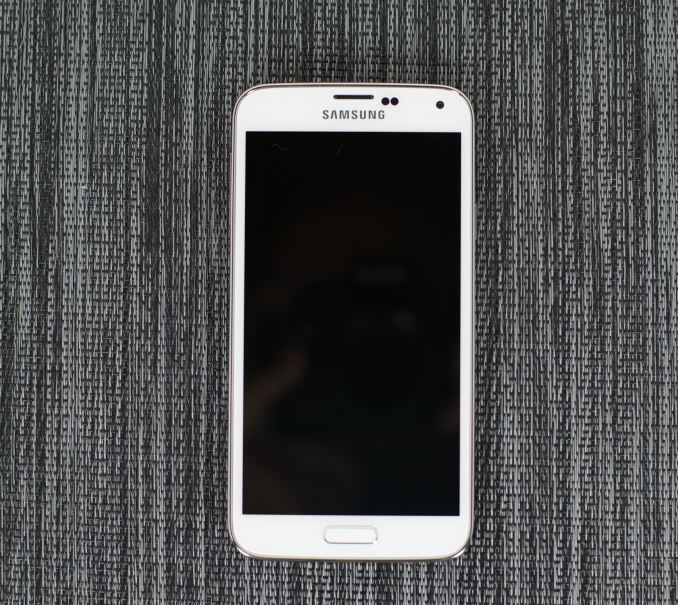
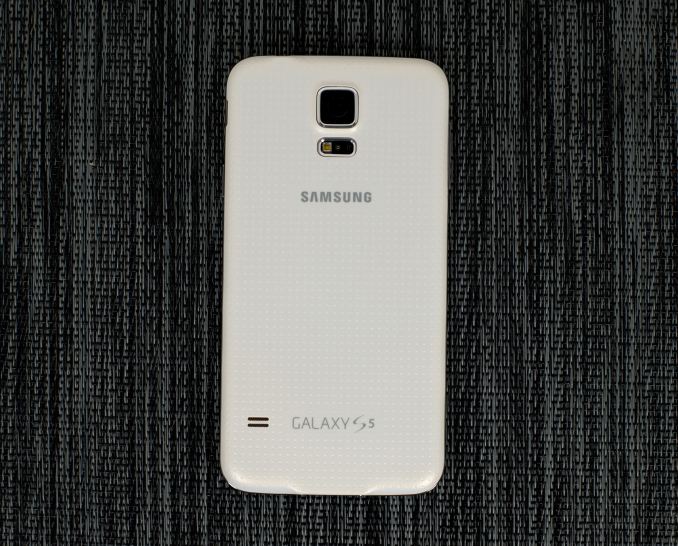
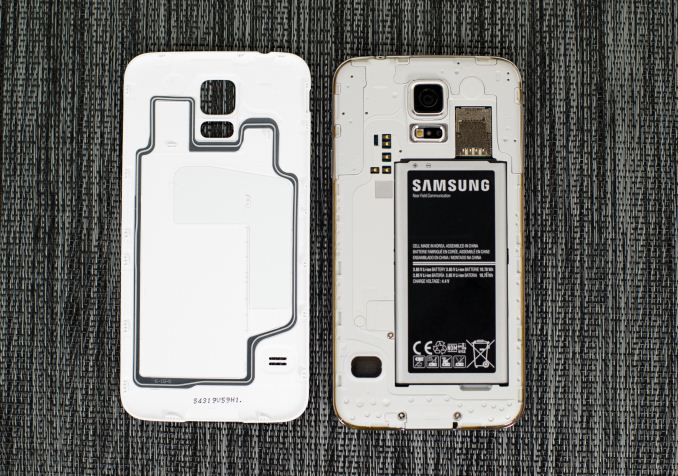








296 Comments
View All Comments
Blairh - Wednesday, April 9, 2014 - link
* 30 grams less than the M8. Substantially shorter too.az06093 - Wednesday, April 9, 2014 - link
Where's the video analysis?xmen77 - Wednesday, April 9, 2014 - link
S5 bestDisplay
S5 improved super amoled
z2 ips on the color RGB lighting with the addition of red and green phosphorus in diodes
All new one ips on the white backlight
M8 have the same quality as in the display М7
Cool backlight Z2, expanding the color gamut and "improves the shades",
actually distorts the color because all the images are designed for
standard sRGB and an extension will only be in the negative. Although
the display is still better than the HTC M8.
Amoled gradually improved and now he has lost almost all the shortcomings, there was only slight, noticeable only during the rapid motion of the screen (in front of screen) "modulation" at low brightness at maximum (it is comfortable in all conditions) this "modulation" No, I do not know why samsung does so in LG G Flex is no such (there is also amoled)
In OLED (Amoled) white whiter IPS, faster response in comparison to LCD
(hundreds of times better than LCD), contrast and black level is perfect
(hundreds of times better than LCD), colors
do not mix with each other,, ideal viewing angles.
Oversaturated color removed using a cinema mode
blog.gsmarena.com/samsung-details-new-galaxy-s5-display-panel/
phonearena.com/news/Samsung-details-its-new-Galaxy-S5-display-the-brightest-most-efficient-OLED-screen-to-date-can-hit-698-nits_id54767
phonearena.com/news/Display-Mate-Samsung-Galaxy-S5-has-the-best-performing-smartphone-display-that-we-have-ever-tested_id54583
i-cdn.phonearena.com/images/articles/116013-image/Samsung-Galaxy-S5-HTC-One-M8-Sony-Xperia-Z2-LG-G-Pro-2-0122.jpg
i-cdn.phonearena.com/images/articles/116012-image/Samsung-Galaxy-S5-HTC-One-M8-Sony-Xperia-Z2-LG-G-Pro-2-012.jpg
i-cdn.phonearena.com/images/articles/116009-image/Samsung-Galaxy-S5-HTC-One-M8-Sony-Xperia-Z2-LG-G-Pro-2-009.jpg
ixbt.com/mobile/images/samsung-galaxy-s5/vs-pict-angle-l.jpg
ixbt.com/mobile/images/samsung-galaxy-s5/vs-white-angle-l.jpg
hi-tech.imgsmail.ru/hitech_img/source/cf/dc/746f7c86490ffdb8e93c035d5e62.jpg
Camera
S5 1/2.6 isocell phase autofocus 6 lenses
z2 1/2.3 bsi 5 lenses
one 1/3 bsi 4 lenses
At S5 even crude firmware (new sensor) better color, detail and less noise
The rest of at the final firmware is very bad, especially in HTC
eprice.com.tw/mobile/talk/124/4899661/1/rv/sony-xperia-z2-review/
eprice.com.tw/mobile/talk/124/4899662/1/rv/sony-xperia-z2-review/
4pda.ru/forum/index.php?showtopic=515584&view=findpost&p=30435226
Waterproof
S5 ip x6
Z2 ip x7
one ip x3
Bezels
S5 is more or less thin bezels
Z2 more or less thin bezels
one big bezels
Performance
S5 2048 MB RAM (Dual-channel) LPDDR3
Z2 3072 MB RAM (Dual-channel) LPDDR3
M8 2048 MB RAM DDR2
phonearena.com/news/HTC-admits-its-High-Performance-Mode-pumped-up-benchmark-scores-for-the-HTC-One-M8_id54509
Body
Metal is bad for the connection know about it all in the industry, aluminum is not a premium material, it is used for beer cans. At s5 soft touch texture like nexus7 instead of glossy plastic s4
doobydoo - Friday, April 11, 2014 - link
Troll post. You say plastic is used for beer cans - plastic is used for trash bags.Aluminium is preferred.
TheSailorMan - Sunday, April 13, 2014 - link
"Preferred" for what? For helmets?? For car bumpers??? .......Aluminum is is the WORST material for smartphones. In many ways.
And YES , same drink in plastic bottle cost more than , if it is in cans. Check it out.
Plastic is MORE expensive than ALUMINUM. Check out this , too
Streamlined - Thursday, April 17, 2014 - link
Samsung Fanboy alert. Metal is far superior to plastic for heat dissipation alone. Not to mention it's more durable. And on what world is plastic more expensive than Aluminum?doobydoo - Friday, April 11, 2014 - link
And the metal phones have no problem with connections, either.ESC2000 - Sunday, April 13, 2014 - link
You just keep telling yourself that. The iPhone has documented connectivity problems. See eghttp://m.digitaltrends.com/mobile/iphone-5-problem... That list further notes that the aluminum chassis is prone to scratches (an apple VP says it's normal and to be expected... Not on my $800 device... Figure out how to prevent it). That list also notes the extreme battery drain problem I experienced on my iPhone 5, which died overnight the first night I owned it (failing to wake me up in the process). Owning an iPhone was a very underwhelming experience for me. After six months I dumped it for a note 2 and then a nexus 5 and have been much more satisfied. And my phone doesn't look like it's been to war like, for example, my stepfather's which has many dents and scratches.
pandemonium - Wednesday, April 9, 2014 - link
It seems silly to me that you don't have a Lumia 1020 and a DSLR in your photo bench marking.crbandiera - Wednesday, April 9, 2014 - link
Very solid r review. Thanks for the useful balanced review. The information and your style as writer is refreshing as I am often times caught forced to ignore reviews due there extreme bias. I feel better equipped to make a purchase and that my expectations of what ever device I choose will be more realistic. Thank you for doing your job well.